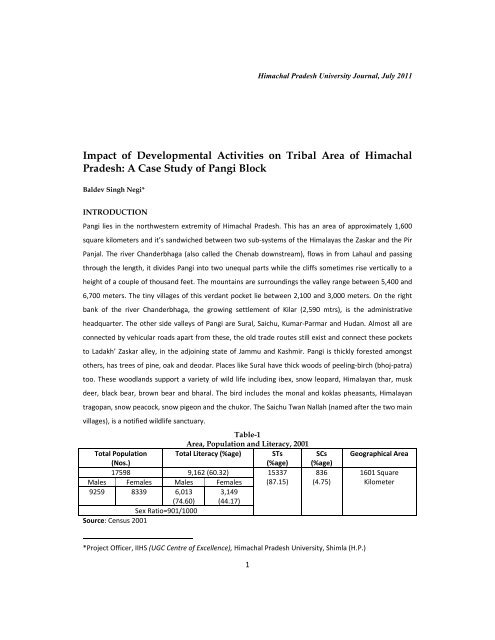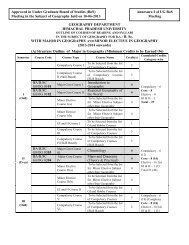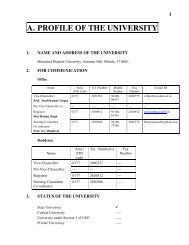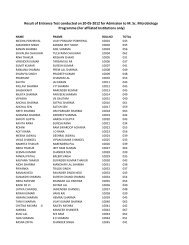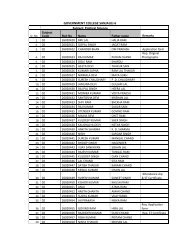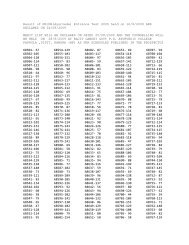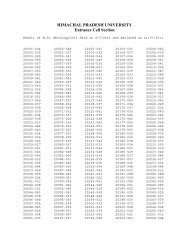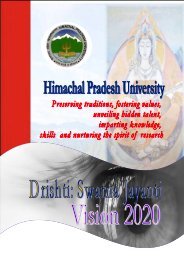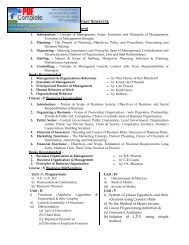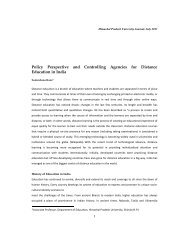Impact of Developmental Activities on Tribal Area of Himachal Pradesh
Impact of Developmental Activities on Tribal Area of Himachal Pradesh
Impact of Developmental Activities on Tribal Area of Himachal Pradesh
Create successful ePaper yourself
Turn your PDF publications into a flip-book with our unique Google optimized e-Paper software.
<strong>Himachal</strong> <strong>Pradesh</strong> University Journal, July 2011<str<strong>on</strong>g>Impact</str<strong>on</strong>g> <str<strong>on</strong>g>of</str<strong>on</strong>g> <str<strong>on</strong>g>Developmental</str<strong>on</strong>g> <str<strong>on</strong>g>Activities</str<strong>on</strong>g> <strong>on</strong> <strong>Tribal</strong> <strong>Area</strong> <str<strong>on</strong>g>of</str<strong>on</strong>g> <strong>Himachal</strong><strong>Pradesh</strong>: A Case Study <str<strong>on</strong>g>of</str<strong>on</strong>g> Pangi BlockBaldev Singh Negi* 1INTRODUCTIONPangi lies in the northwestern extremity <str<strong>on</strong>g>of</str<strong>on</strong>g> <strong>Himachal</strong> <strong>Pradesh</strong>. This has an area <str<strong>on</strong>g>of</str<strong>on</strong>g> approximately 1,600square kilometers and it’s sandwiched between two sub‐systems <str<strong>on</strong>g>of</str<strong>on</strong>g> the Himalayas the Zaskar and the PirPanjal. The river Chanderbhaga (also called the Chenab downstream), flows in from Lahaul and passingthrough the length, it divides Pangi into two unequal parts while the cliffs sometimes rise vertically to aheight <str<strong>on</strong>g>of</str<strong>on</strong>g> a couple <str<strong>on</strong>g>of</str<strong>on</strong>g> thousand feet. The mountains are surroundings the valley range between 5,400 and6,700 meters. The tiny villages <str<strong>on</strong>g>of</str<strong>on</strong>g> this verdant pocket lie between 2,100 and 3,000 meters. On the rightbank <str<strong>on</strong>g>of</str<strong>on</strong>g> the river Chanderbhaga, the growing settlement <str<strong>on</strong>g>of</str<strong>on</strong>g> Kilar (2,590 mtrs), is the administrativeheadquarter. The other side valleys <str<strong>on</strong>g>of</str<strong>on</strong>g> Pangi are Sural, Saichu, Kumar‐Parmar and Hudan. Almost all arec<strong>on</strong>nected by vehicular roads apart from these, the old trade routes still exist and c<strong>on</strong>nect these pocketsto Ladakh’ Zaskar alley, in the adjoining state <str<strong>on</strong>g>of</str<strong>on</strong>g> Jammu and Kashmir. Pangi is thickly forested am<strong>on</strong>gstothers, has trees <str<strong>on</strong>g>of</str<strong>on</strong>g> pine, oak and deodar. Places like Sural have thick woods <str<strong>on</strong>g>of</str<strong>on</strong>g> peeling‐birch (bhoj‐patra)too. These woodlands support a variety <str<strong>on</strong>g>of</str<strong>on</strong>g> wild life including ibex, snow leopard, Himalayan thar, muskdeer, black bear, brown bear and bharal. The bird includes the m<strong>on</strong>al and koklas pheasants, Himalayantragopan, snow peacock, snow pige<strong>on</strong> and the chukor. The Saichu Twan Nallah (named after the two mainvillages), is a notified wildlife sanctuary.Table-1<strong>Area</strong>, Populati<strong>on</strong> and Literacy, 2001Total Populati<strong>on</strong> Total Literacy (%age) STs SCs Geographical <strong>Area</strong>(Nos.)(%age) (%age)17598 9,162 (60.32) 15337 836 1601 SquareMales Females Males Females (87.15) (4.75) Kilometer9259 8339 6,013 3,149(74.60) (44.17)Sex Ratio=901/1000Source: Census 2001*Project Officer, IIHS (UGC Centre <str<strong>on</strong>g>of</str<strong>on</strong>g> Excellence), <strong>Himachal</strong> <strong>Pradesh</strong> University, Shimla (H.P.)1
<strong>Himachal</strong> <strong>Pradesh</strong> University Journal, July 2011According to 2001 Census, the entire tehsil is rural having a populati<strong>on</strong>s <str<strong>on</strong>g>of</str<strong>on</strong>g> 17,598 out <str<strong>on</strong>g>of</str<strong>on</strong>g> which 15,337(87.15 percent) are scheduled tribe (STs) and 4922 (13.21 percent) are scheduled castes (SCs) populati<strong>on</strong>.The literacy positi<strong>on</strong> according to 2001, Census there are 9,162 (60.32 percent) literates, out <str<strong>on</strong>g>of</str<strong>on</strong>g> which themale literates are 6,013 (74.60 percent) and there are 3,149 (44.17 percent) female literates. Populati<strong>on</strong>sunder the age group <str<strong>on</strong>g>of</str<strong>on</strong>g> 0‐6 year are 2408 (1,199 males and 1209 females) pers<strong>on</strong>s.Climate: The tract lies in the semi arid z<strong>on</strong>e <str<strong>on</strong>g>of</str<strong>on</strong>g> the inner Himalayas. Where m<strong>on</strong>so<strong>on</strong> rains penetrate withdifficulty, but severe winters, heavy snowfall, str<strong>on</strong>g winds and frequent avalanches are a prominentfeature. The winter lasts from November to April, but snow usually begins to fall <strong>on</strong> the sec<strong>on</strong>d half <str<strong>on</strong>g>of</str<strong>on</strong>g>October or early November, reaching lower altitudes by the middle <str<strong>on</strong>g>of</str<strong>on</strong>g> December. Any field works frommiddle <str<strong>on</strong>g>of</str<strong>on</strong>g> December to March are thus normally impossible. The change over from winter to summer isgradual, March and April are cool and bright, but the snowfalls may occur even during these m<strong>on</strong>ths. Thetemperature begins to rise rapidly after the beginning <str<strong>on</strong>g>of</str<strong>on</strong>g> May and c<strong>on</strong>tinues to register this trend tillAugust. The period from middle <str<strong>on</strong>g>of</str<strong>on</strong>g> May to end <str<strong>on</strong>g>of</str<strong>on</strong>g> June and from 15 th September to 15 th October isgenerally dry and most <str<strong>on</strong>g>of</str<strong>on</strong>g> the mortality in young or new growth takes place during this period. The snowbegins to disappear in March although as already aid small falls may occur even in April. The passesreopen in May, but the snow lasts <strong>on</strong> them till July and some <str<strong>on</strong>g>of</str<strong>on</strong>g> the higher peaks remain perpetuallycovered with snow. The shade temperature at Kilar, however, seldom exceeds 27 0 C or falls below ‐10 0 .Administrative set‐up and PRIs: Pangi block <str<strong>on</strong>g>of</str<strong>on</strong>g> Chamba district is governed under the single lineadministrati<strong>on</strong> (SLA) headed by the Resident Commissi<strong>on</strong>er (Officer <str<strong>on</strong>g>of</str<strong>on</strong>g> IAS rank). Who enjoys the fullpowers <str<strong>on</strong>g>of</str<strong>on</strong>g> Deputy Commissi<strong>on</strong>er at the district headquarter and the powers <str<strong>on</strong>g>of</str<strong>on</strong>g> Principal Secretary <strong>Tribal</strong>Development at the state level with in the block. It is worthy to note here that the SLA was started in April1986 in Pangi block <strong>on</strong> experiment level but after the w<strong>on</strong>derful results <str<strong>on</strong>g>of</str<strong>on</strong>g> this system, government <str<strong>on</strong>g>of</str<strong>on</strong>g><strong>Himachal</strong> <strong>Pradesh</strong> has implemented it in whole tribal areas <str<strong>on</strong>g>of</str<strong>on</strong>g> the state. Out <str<strong>on</strong>g>of</str<strong>on</strong>g> seven blocks in Chambadistrict there are two tribal blocks and Pangi <strong>on</strong>e <str<strong>on</strong>g>of</str<strong>on</strong>g> it. There are <strong>on</strong>e tehsil and sub‐divisi<strong>on</strong> <str<strong>on</strong>g>of</str<strong>on</strong>g> same nameunder this block. For the assembly c<strong>on</strong>stituency it is attached with Bharmour area and for parliament it isthe part <str<strong>on</strong>g>of</str<strong>on</strong>g> Mandi c<strong>on</strong>stituency. The whole Pangi block comprises 16 Gram Panchayats, 8 PanchayatSamities and <strong>on</strong>e Zila Parishad.Workers Distributi<strong>on</strong> in the Block (1971‐2001): The pace <str<strong>on</strong>g>of</str<strong>on</strong>g> ec<strong>on</strong>omic development depends up<strong>on</strong> theavailability or various factors <str<strong>on</strong>g>of</str<strong>on</strong>g> producti<strong>on</strong>. The mere availability <str<strong>on</strong>g>of</str<strong>on</strong>g> the factors <str<strong>on</strong>g>of</str<strong>on</strong>g> producti<strong>on</strong> will not leadto ec<strong>on</strong>omic development. Special budgetary provisi<strong>on</strong>s have been made by the respective state andcentral government for the development <str<strong>on</strong>g>of</str<strong>on</strong>g> tribal areas. This flow <str<strong>on</strong>g>of</str<strong>on</strong>g> m<strong>on</strong>ey to tribal areas results in tovarious kind <str<strong>on</strong>g>of</str<strong>on</strong>g> developmental activities in the sectors <str<strong>on</strong>g>of</str<strong>on</strong>g> agriculture, horticulture, forestry etc. All thesedevelopmental activities have serious repercussi<strong>on</strong>s to the land use pattern. Moreover, the ever growing2
<strong>Himachal</strong> <strong>Pradesh</strong> University Journal, July 2011populati<strong>on</strong> and influx <str<strong>on</strong>g>of</str<strong>on</strong>g> migratory labourers also put tremendous pressure <strong>on</strong> the available resources.Therefore, study <str<strong>on</strong>g>of</str<strong>on</strong>g> these variables is <str<strong>on</strong>g>of</str<strong>on</strong>g> immense importance so as to understand the changing land usepattern.Table-2Workers Distributi<strong>on</strong>, Percentage <str<strong>on</strong>g>of</str<strong>on</strong>g> workers to total populati<strong>on</strong> and n<strong>on</strong>-agriculture worker tototal numbers <str<strong>on</strong>g>of</str<strong>on</strong>g> workersSr. No. 1971 1981 1991 20011. Total Populati<strong>on</strong> 9794 12256 14960 175982. Main 6433 5260 53303. Marginal 750 2057 40864. N<strong>on</strong>‐workers 5073 7643 81825. Am<strong>on</strong>g main workers6. Cultivator 4691 5431 3423 26767. Agril. Labourers 4 8 12 288. H.H.Ind. Mfg. Processing services &9 30 27repairs9. Other workers 678 985 1795 259910. Workers <str<strong>on</strong>g>of</str<strong>on</strong>g> the Block 5460 6433 5260 533011. Percentage <str<strong>on</strong>g>of</str<strong>on</strong>g> workers to total 55.7 52.5 35.2 30.29populati<strong>on</strong>12. N<strong>on</strong>‐Agriculture workers <str<strong>on</strong>g>of</str<strong>on</strong>g> the block 765 994 1604 160413. Percentage <str<strong>on</strong>g>of</str<strong>on</strong>g> n<strong>on</strong>‐agriculture workers 14.0 15.5 30.5 9.12to total workersSource: ARO, Pangi & Statistical Pr<str<strong>on</strong>g>of</str<strong>on</strong>g>ile, Government <str<strong>on</strong>g>of</str<strong>on</strong>g> <strong>Himachal</strong> <strong>Pradesh</strong>, Shimla & District Census HandBookIn the last four decades, the populati<strong>on</strong> <str<strong>on</strong>g>of</str<strong>on</strong>g> Pangi has been almost doubled. Here it is important to menti<strong>on</strong>that the above figures do not include the migratory labourers and floating populati<strong>on</strong>. This increasedpopulati<strong>on</strong> has serious repercussi<strong>on</strong>s to the available land and other natural resources. The growingec<strong>on</strong>omic activities have resulted in to changed occupati<strong>on</strong>al structure. Occupati<strong>on</strong> structure in Pangivalley has noticed drastic changes in last four decades. In the 70s and early 80s large number <str<strong>on</strong>g>of</str<strong>on</strong>g> Pangwalsor the people <str<strong>on</strong>g>of</str<strong>on</strong>g> Pangi used to migrate to the neighbouring districts <str<strong>on</strong>g>of</str<strong>on</strong>g> Chamba, Kangra, Kullu etc., but <str<strong>on</strong>g>of</str<strong>on</strong>g>late this trend has been reversed to a reas<strong>on</strong>able extent, because <str<strong>on</strong>g>of</str<strong>on</strong>g> increased ec<strong>on</strong>omic activities in Pangivalley, e.g. c<strong>on</strong>structi<strong>on</strong> <str<strong>on</strong>g>of</str<strong>on</strong>g> road works buildings etc. It is evident from the above said table that there hasbeen a significant decrease in the populati<strong>on</strong> <str<strong>on</strong>g>of</str<strong>on</strong>g> cultivators. This is mainly because <str<strong>on</strong>g>of</str<strong>on</strong>g> agriculture isbecoming n<strong>on</strong>‐viable and alternate employment opportunities are being generated through various <strong>on</strong>goingc<strong>on</strong>structi<strong>on</strong> work. The c<strong>on</strong>structi<strong>on</strong> boom <str<strong>on</strong>g>of</str<strong>on</strong>g> Pangi valley has created more opportunity formarginal and casual workers. In spite <str<strong>on</strong>g>of</str<strong>on</strong>g> increased c<strong>on</strong>structi<strong>on</strong> activity the modern sector <str<strong>on</strong>g>of</str<strong>on</strong>g> the ec<strong>on</strong>omyhas yet to be developed in Pangi valley, which includes industrial and manufacturing sector. This is evident3
<strong>Himachal</strong> <strong>Pradesh</strong> University Journal, July 2011from the fact that percentage <str<strong>on</strong>g>of</str<strong>on</strong>g> workers to total populati<strong>on</strong> has substantially declined over a period <str<strong>on</strong>g>of</str<strong>on</strong>g>time. This further reveals that skill <str<strong>on</strong>g>of</str<strong>on</strong>g> the local populati<strong>on</strong> has yet to be developed to match the newec<strong>on</strong>omic activities. Moreover, this declining trend can result in huge unemployment am<strong>on</strong>g the localpopulati<strong>on</strong>.Table-3Net <strong>Area</strong> Sown Per Agriculture Workers and Cropping IntensityYearGross <strong>Area</strong>sown(Hectare)Net <strong>Area</strong>(Hectare)Numbers <str<strong>on</strong>g>of</str<strong>on</strong>g>AgricultureworkersNet area sown PeragricultureworkersCroppingintensity1971 1,831 1,650 4,695 0.35 1.101981 2,163 1,607 5,439 0.29 1.341991 2,167 1,670 2,835 0.59 1.302001 2,497 1,970 1,976 0.54 1.26Source: DSO <str<strong>on</strong>g>of</str<strong>on</strong>g>fice, ChambaIn any tribal or primitive ec<strong>on</strong>omy, the most important sector is primary sector, which comprises <str<strong>on</strong>g>of</str<strong>on</strong>g>agriculture and allied activities. By seeing the topography <str<strong>on</strong>g>of</str<strong>on</strong>g> Pangi valley, it can be c<strong>on</strong>cluded that eventhe agriculture cannot be extended bey<strong>on</strong>d certain limits because valley is surrounded by high mountainpeaks and deep river bed. However, there has been a marginal increase in the gross and net area underagriculture. Further, the agriculture sector has yet to experience the fruits <str<strong>on</strong>g>of</str<strong>on</strong>g> green revoluti<strong>on</strong> because <str<strong>on</strong>g>of</str<strong>on</strong>g>lack <str<strong>on</strong>g>of</str<strong>on</strong>g> inspirati<strong>on</strong> and facilities <str<strong>on</strong>g>of</str<strong>on</strong>g> high yielding variety seed, modern agricultural equipments and lack <str<strong>on</strong>g>of</str<strong>on</strong>g>awareness. The cropping intensity in the Pangi valley has slightly shown improvement in the decade <str<strong>on</strong>g>of</str<strong>on</strong>g> 70sbut after that it is still stagnating. This shows that agriculture in the Pangi valley has a little potential andobviously for socio‐ec<strong>on</strong>omic transformati<strong>on</strong>, alternate sector <str<strong>on</strong>g>of</str<strong>on</strong>g> the ec<strong>on</strong>omy needs to be developed.Development <str<strong>on</strong>g>of</str<strong>on</strong>g> roads network (1971‐2007): Roads are harbingers <str<strong>on</strong>g>of</str<strong>on</strong>g> change and progress. The Pangivalley is beset with a peculiar problem having a vast area with a thinly spread populati<strong>on</strong>. Roads are thelifeline <str<strong>on</strong>g>of</str<strong>on</strong>g> the tribal people because there is no other mode <str<strong>on</strong>g>of</str<strong>on</strong>g> transportati<strong>on</strong>. Ec<strong>on</strong>omic and socialdevelopment <str<strong>on</strong>g>of</str<strong>on</strong>g> Pangi depends mostly <strong>on</strong> efficient system <str<strong>on</strong>g>of</str<strong>on</strong>g> roads and transportati<strong>on</strong>. Roads are thelifelines <str<strong>on</strong>g>of</str<strong>on</strong>g> the people further; roads and transportati<strong>on</strong> play a vital role in the process <str<strong>on</strong>g>of</str<strong>on</strong>g> modernizati<strong>on</strong>.The opening <str<strong>on</strong>g>of</str<strong>on</strong>g> the tribal areas by a carefully planned system <str<strong>on</strong>g>of</str<strong>on</strong>g> communicati<strong>on</strong> is the basis <str<strong>on</strong>g>of</str<strong>on</strong>g> alldevelopment (Singh, 1984). In the last four decades, there has been a tremendous expansi<strong>on</strong> <str<strong>on</strong>g>of</str<strong>on</strong>g> roads inPangi valley.4
<strong>Himachal</strong> <strong>Pradesh</strong> University Journal, July 2011Table-5Literacy Growth in PangiCensus Total Populati<strong>on</strong> Growth Literacy Growth Male Female1971 9794 992913 79(10.1)(9.3) (0.8)1981 12256 25.13 2400 94.05 2060 340(19.6)(16.8) (2.8)1991 14960 22.06 4673 58.77 3477 1196(31.2)(23.2) (8.0)2001 17598 17.63 9162 91.83 6013 3149(59.7)(39.2) (20.5)Source: Compiled from District Statistical Office Chamba and Annual <strong>Tribal</strong> Sub‐Plans, <strong>Tribal</strong> DevelopmentDepartment, Government <str<strong>on</strong>g>of</str<strong>on</strong>g> <strong>Himachal</strong> <strong>Pradesh</strong>, Shimla.There has been a tremendous expansi<strong>on</strong> in the field <str<strong>on</strong>g>of</str<strong>on</strong>g> literacy, which is evident from the above table thatin 1971 the literacy rate which was just 10.1 per cent has reached around 60 per cent in 2001. This meansthe tribal area <str<strong>on</strong>g>of</str<strong>on</strong>g> Pangi has performed more than satisfactory because it has come close to the overallstate’s literacy rate. Here it is important to menti<strong>on</strong> that huge network <str<strong>on</strong>g>of</str<strong>on</strong>g> educati<strong>on</strong> has been created inthe tribal areas <str<strong>on</strong>g>of</str<strong>on</strong>g> Pangi. Nevertheless, it is pertinent to note that still lot needs to be d<strong>on</strong>e in this field.The female literacy rate is still very low. Obviously, the programmes Sarav Shiksha Abhiyan (SSA), etc.needs to be implemented in a more vigorous manner. With the existing spread <str<strong>on</strong>g>of</str<strong>on</strong>g> educati<strong>on</strong>, it will not bepossible for the state to achieve the level <str<strong>on</strong>g>of</str<strong>on</strong>g> 100 per cent literacy by 2012.Table-6Growth <str<strong>on</strong>g>of</str<strong>on</strong>g> Educati<strong>on</strong>al Instituti<strong>on</strong>sInstituti<strong>on</strong>s 1971 1981 1991 2001 2007Primary Schools 28 43 48 62 64Middle Schools 4 4 3 13 18High Schools 2 5 5 5 6Sr. Sec. Schools ‐‐ 1 2 2 5College ‐‐ ‐‐ ‐‐ ‐‐ 1ITI ‐‐ ‐‐ ‐‐ ‐‐ 1Total 34 53 58 82 95Source: ARO, Pangi & Statistical Pr<str<strong>on</strong>g>of</str<strong>on</strong>g>ile, Government <str<strong>on</strong>g>of</str<strong>on</strong>g> <strong>Himachal</strong> <strong>Pradesh</strong>, ShimlaAbove table present the picture <str<strong>on</strong>g>of</str<strong>on</strong>g> available educati<strong>on</strong>al instituti<strong>on</strong>s during the course <str<strong>on</strong>g>of</str<strong>on</strong>g> four decades inPangi block. It shows that there were 34 educati<strong>on</strong>al instituti<strong>on</strong>s in Pangi block in 1971, out <str<strong>on</strong>g>of</str<strong>on</strong>g> which therewere 28 primary, 4 middle and <strong>on</strong>ly 2 high schools. In 1981 the number <str<strong>on</strong>g>of</str<strong>on</strong>g> educati<strong>on</strong> instituti<strong>on</strong>s reached53 including 43 primary schools, 4middle, 5 high and 1 senior sec<strong>on</strong>dary school. In 1991 the number <str<strong>on</strong>g>of</str<strong>on</strong>g>these educati<strong>on</strong>al instituti<strong>on</strong>s reached 58 including the 48 primary, 3 middle, 5 high and 2 seniorsec<strong>on</strong>dary schools, in 2001 it reached up to the figure <str<strong>on</strong>g>of</str<strong>on</strong>g> 82 instituti<strong>on</strong>s comprising 62 primary, 13 middle,6
<strong>Himachal</strong> <strong>Pradesh</strong> University Journal, July 20115 high and 3 sec<strong>on</strong>dary schools. The recent data shows further progress in the opening <str<strong>on</strong>g>of</str<strong>on</strong>g> the newinstituti<strong>on</strong>s and it reached up to 95 instituti<strong>on</strong>s with 64 primary schools, 18middle, 6 high and 5 sec<strong>on</strong>daryschools. Besides these instituti<strong>on</strong>s government has opened a degree college and <strong>on</strong>e Industrial TrainingInstitute in 2007.The land used for various educati<strong>on</strong>al instituti<strong>on</strong>s can be estimated with the help <str<strong>on</strong>g>of</str<strong>on</strong>g> following formula. Ithas been assumed that each educati<strong>on</strong>al instituti<strong>on</strong> needs at least 0.5 to 1 sq. km area. This means thatapproximate area covered by these institutes around 60 to 70 sq. kms. It is expected that so as to achieve100 per cent literacy and upgrading the technical skills <str<strong>on</strong>g>of</str<strong>on</strong>g> the people, more such instituti<strong>on</strong>s are requiredin the near future. Since, the valley has limited land; therefore, development <str<strong>on</strong>g>of</str<strong>on</strong>g> such instituti<strong>on</strong>s needs aserious planning so that envir<strong>on</strong>ment and ecology <str<strong>on</strong>g>of</str<strong>on</strong>g> the valley may be protected.Growth <str<strong>on</strong>g>of</str<strong>on</strong>g> medical and veterinary instituti<strong>on</strong>s (1971‐2007): Similarly, the growth <str<strong>on</strong>g>of</str<strong>on</strong>g> social infrastructurein terms <str<strong>on</strong>g>of</str<strong>on</strong>g> medical and veterinary instituti<strong>on</strong>s also has implicati<strong>on</strong>s <strong>on</strong> land use. Health is the basic unit <str<strong>on</strong>g>of</str<strong>on</strong>g>the social infrastructure and it is basic need <str<strong>on</strong>g>of</str<strong>on</strong>g> an individual. It makes the nati<strong>on</strong> progress in socioec<strong>on</strong>omic,scientific, literary and cultural spheres. Health is both an input and output directly linked withthe development. Rapid and equitable health care system stimulates the development by improvinghuman productivity. Investment in health is investment in human capital. Therefore, akin to educati<strong>on</strong>,provisi<strong>on</strong> <str<strong>on</strong>g>of</str<strong>on</strong>g> medical and health facilities in the tribal area <str<strong>on</strong>g>of</str<strong>on</strong>g> <strong>Himachal</strong> <strong>Pradesh</strong> is a difficult and costlypropositi<strong>on</strong>.Table-7Growth <str<strong>on</strong>g>of</str<strong>on</strong>g> Medical Instituti<strong>on</strong>sSr. No. Instituti<strong>on</strong>s 1971 1981 1991 2001 20071. Allopathic2. Civil Hospital ‐‐ 1 1 1 13. PHCs 1 ‐‐ 3 4 44. CHCs/Rural Hospitals ‐‐ ‐‐ ‐‐ ‐‐5. Civil Dispensaries 1 1 ‐‐ ‐‐6. Sub‐centre ‐‐ ‐‐ ‐‐ 15 167. Winter health posts ‐‐ ‐‐ ‐‐ ‐‐ ‐‐8. Ayurvedic9. Hospital ‐‐ ‐‐ ‐‐ ‐‐ 110. Dispensaries 3 3 4 7 711. Total 5 5 8 27 2912. Medical Instituti<strong>on</strong>s per lakh populati<strong>on</strong> 160Source: ARO, Pangi & Statistical Pr<str<strong>on</strong>g>of</str<strong>on</strong>g>ile, Government <str<strong>on</strong>g>of</str<strong>on</strong>g> <strong>Himachal</strong> <strong>Pradesh</strong>, Shimla7
<strong>Himachal</strong> <strong>Pradesh</strong> University Journal, July 2011Above table reveals that there were <strong>on</strong>ly five health instituti<strong>on</strong>s in 1971 with the whole Pangi bock, thenumbers <str<strong>on</strong>g>of</str<strong>on</strong>g> these instituti<strong>on</strong>s increased up to 8 instituti<strong>on</strong>s in 1991, out <str<strong>on</strong>g>of</str<strong>on</strong>g> which there were <strong>on</strong>e civilhospital, three PHCs and four Ayurvedic dispensaries. Table further shows that increase up to 27 medicalinstituti<strong>on</strong>s, out <str<strong>on</strong>g>of</str<strong>on</strong>g> which there were <strong>on</strong>e civil hospital, four PHCs, fifteen sub‐center and seven Ayurvedicdispensaries. Such a big increase was due to the opening <str<strong>on</strong>g>of</str<strong>on</strong>g> 14 health sub‐center almost covering allvillages <str<strong>on</strong>g>of</str<strong>on</strong>g> the valley. Table shows that according to the recent data the number <str<strong>on</strong>g>of</str<strong>on</strong>g> medical institute thereare total 28 medical instituti<strong>on</strong>s in the Pangi Block comprising <strong>on</strong>e civil hospital four PHCs, sixteen subcenterand eight Ayurvedic instituti<strong>on</strong>s including <strong>on</strong>e hospital and seven dispensaries. Similar to themedical instituti<strong>on</strong>, following table dem<strong>on</strong>strates the picture <str<strong>on</strong>g>of</str<strong>on</strong>g> veterinary instituti<strong>on</strong> during the course <str<strong>on</strong>g>of</str<strong>on</strong>g>last four decades.Table-8Growth <str<strong>on</strong>g>of</str<strong>on</strong>g> Veterinary Instituti<strong>on</strong>s1971 1981 1991 2001 20071. Veterinary Hospital 1 2 4 5 52. Veterinary Dispensaries 4 6 9 14 15Total 5 8 13 19 20Source: DSO <str<strong>on</strong>g>of</str<strong>on</strong>g>fice, ChambaAbove table shows that there were <strong>on</strong>ly veterinary instituti<strong>on</strong>s in Pangi block comprising <strong>on</strong>e veterinaryhospital and 4 dispensaries, this number increased up to 8 instituti<strong>on</strong>s in 1981, 13 in 1991, 19 in 2001 andaccording to the data <str<strong>on</strong>g>of</str<strong>on</strong>g> 2007 this numbers increased up to 20 including 5 veterinary hospital and 15dispensaries.CONCLUSIONThe data shows that after the initiati<strong>on</strong> <str<strong>on</strong>g>of</str<strong>on</strong>g> tribal sub‐plan from 1974 and the implementati<strong>on</strong> <str<strong>on</strong>g>of</str<strong>on</strong>g> single lineadministrati<strong>on</strong> (SLA) in 1986 a vast network <str<strong>on</strong>g>of</str<strong>on</strong>g> basic infrastructure facilities in such as roads, educati<strong>on</strong>alinstituti<strong>on</strong>s, health centre have been established. This was not <strong>on</strong>ly important but necessary since thisarea is inaccessible, marginalized with people living in adverse climatic c<strong>on</strong>diti<strong>on</strong>s. Since, basicinfrastructure facilities have been provided under different government schemes the need <str<strong>on</strong>g>of</str<strong>on</strong>g> the hour isc<strong>on</strong>solidati<strong>on</strong> <str<strong>on</strong>g>of</str<strong>on</strong>g> these facilities and enhancing their quality. In the next phase it is suggested that locati<strong>on</strong>specific employment / income generating activities should be promoted in this area. This will help in8
<strong>Himachal</strong> <strong>Pradesh</strong> University Journal, July 2011lessening out migrati<strong>on</strong> <str<strong>on</strong>g>of</str<strong>on</strong>g> tribal people to different areas <str<strong>on</strong>g>of</str<strong>on</strong>g> the state and ultimately help in maintainingtheir socio‐cultural balance.REFERENCESB.D. Sharma, Administrati<strong>on</strong> for <strong>Tribal</strong> Development, The Indian Journal <str<strong>on</strong>g>of</str<strong>on</strong>g> Public Administrati<strong>on</strong>, Vol.XXIII, 1977, pp. 515‐539.Department <str<strong>on</strong>g>of</str<strong>on</strong>g> <strong>Tribal</strong> Development, Government <str<strong>on</strong>g>of</str<strong>on</strong>g> <strong>Himachal</strong> <strong>Pradesh</strong>, Annual <strong>Tribal</strong> Sub‐Plan, 1974‐2009Directorate <str<strong>on</strong>g>of</str<strong>on</strong>g> Ec<strong>on</strong>omics and Statistics, <strong>Himachal</strong> <strong>Pradesh</strong>, Stastical Outline <str<strong>on</strong>g>of</str<strong>on</strong>g> <strong>Himachal</strong> <strong>Pradesh</strong>, 2001.Directorate <str<strong>on</strong>g>of</str<strong>on</strong>g> Industrializati<strong>on</strong>, Industrial Policy, Government <str<strong>on</strong>g>of</str<strong>on</strong>g> <strong>Himachal</strong> <strong>Pradesh</strong>, 2004.Ministry <str<strong>on</strong>g>of</str<strong>on</strong>g> <strong>Tribal</strong> Affairs, Nati<strong>on</strong>al Policy <strong>on</strong> <strong>Tribal</strong> (Draft), Government <str<strong>on</strong>g>of</str<strong>on</strong>g> India, New Dehli, 2006.<strong>Himachal</strong><strong>Pradesh</strong>, Chamba district: 1963 Batala, 1964. (Negi T.S. edt.)Punjab State Gazetteer‐Chamba State, Part A. Vol. XXI A, 1904: Lahore, 1910.9


